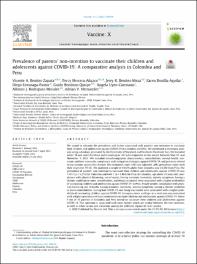Mostrar el registro sencillo del ítem
Prevalence of parents' non-intention to vaccinate their children and adolescents against COVID-19: A comparative analysis in Colombia and Peru
| dc.contributor.author | Benites-Zapata, Vicente A. | es_ES |
| dc.contributor.author | Urrunaga-Pastor, Diego | es_ES |
| dc.contributor.author | Bendezu-Quispe, Guido | es_ES |
| dc.contributor.author | Uyen-Cateriano, Angela | es_ES |
| dc.contributor.author | Rodriguez-Morales, Alfonso J. | es_ES |
| dc.contributor.author | Hernandez, Adrian V. | es_ES |
| dc.date.accessioned | 2022-11-23T15:38:16Z | |
| dc.date.available | 2022-11-23T15:38:16Z | |
| dc.date.issued | 2022-07-27 | |
| dc.identifier.uri | https://hdl.handle.net/20.500.13053/7212 | |
| dc.description.abstract | "We aimed to estimate the prevalence and factors associated with parents’ non-intention to vaccinate their children and adolescents against COVID-19 in Colombia and Peru. We performed a secondary anal- ysis using a database generated by the University of Maryland and Facebook (Facebook, Inc). We Included adult (18 and over) Facebook users residing in LAC who responded to the survey between May 20, and November 5, 2021. We Included sociodemographic characteristics, comorbidities, mental health, eco- nomic and food insecurity, compliance with mitigation strategies against COVID-19, and practices related to vaccination against this disease. We estimated crude (cPR) and adjusted (aPR) prevalence ratios with their respective 95 %CI. We analyzed a sample of 44,678 adults from Colombia and 24,302 from Peru. The prevalence of parents’ non-intention to vaccinate their children and adolescents against COVID-19 was 7.41 % (n = 3,274) for Colombia and 6.64 % (n = 1,464) for Peru. In Colombia, age above 35 years old, com- pliance with physical distancing, use of masks, having economic insecurity, anxiety symptoms, having a chronic condition or more comorbidities, and being vaccinated were associated with a higher probability of vaccinating children and adolescents against COVID-19. In Peru, female gender, compliance with phys- ical distancing, use of masks, having economic insecurity, anxiety symptoms, having a chronic condition or more comorbidities, having had COVID-19, and being vaccinated were associated with a higher prob- ability of vaccinating children against COVID-19. Living in a town, a village, or a rural area was associated with a higher prevalence of non-intention to vaccinate children and adolescents against COVID-19. About 9 out of 10 parents in Colombia and Peru intend to vaccinate their children and adolescents against COVID-19. This intention is associated with some factors which are similar between the two countries, as well as other factors and variations among the different regions of each country." | es_ES |
| dc.format | application/pdf | es_ES |
| dc.language.iso | eng | es_ES |
| dc.publisher | Elsevier Ltd | es_ES |
| dc.rights | info:eu-repo/semantics/openAccess | es_ES |
| dc.rights.uri | https://creativecommons.org/licenses/by/4.0/ | es_ES |
| dc.subject | SARS-CoV-2 COVID-19 Vaccines Vaccination Refusal Vaccination Child Adolescent Parents Colombia Peru | es_ES |
| dc.title | Prevalence of parents' non-intention to vaccinate their children and adolescents against COVID-19: A comparative analysis in Colombia and Peru | es_ES |
| dc.type | info:eu-repo/semantics/article | es_ES |
| dc.identifier.doi | https://doi.org/10.1016/j.jvacx.2022.100198 | es_ES |
| dc.type.version | info:eu-repo/semantics/publishedVersion | es_ES |
| dc.publisher.country | NL | es_ES |
| dc.subject.ocde | http://purl.org/pe-repo/ocde/ford#3.03.00 | es_ES |
Ficheros en el ítem
Este ítem aparece en la(s) siguiente(s) colección(ones)
-
SCOPUS [381]


